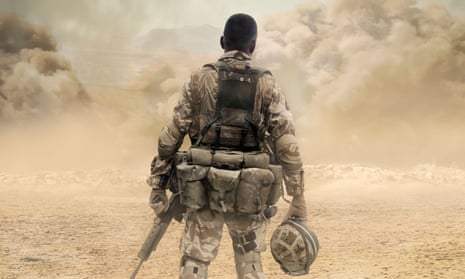Harry Parker’s first novel begins just after British army captain Tom Barnes steps on an IED. The location is unspecified, but Parker’s own biography – an army officer, he lost both his legs to an IED in 2009 – suggests Afghanistan. Like Parker, Barnes loses one leg to the blast and one to infection, although that isn’t apparent right away since the book’s chapters jump back and forward in time, describing scenes from Barnes’s deployment, his lengthy and traumatic recuperation, and the lives of locals, including insurgents, whose paths he crosses. Parker has said he wanted it to be possible to read the book’s chapters “in any order, because that’s what it’s like to be blown up. I liked the idea of creating a puzzle with each chapter.”
Parker’s narrative might jump from the chaos of an Afghan firefight to a Sainsbury’s car park and back again, but it never feels all that puzzling: his prose, economical but evocative and at times wincingly graphic, confidently shepherds you through the ruptured timeline. What might cause puzzlement, however, is his decision to rotate the first-person narrative voice not between characters, but between objects involved in Captain Barnes’s story. The first three chapters, for example, are narrated by a tourniquet, a bag of fertiliser, and a boot. This is an interesting idea, and one that gives Parker freedom to shift his focus between characters and events in a way that might otherwise feel bizarrely staccato, but it also raises questions that impede the story. The more you wonder why body armour is more poetic than a running shoe, or why a detonating bomb favours alliteration, the less absorbed in the book you become.
Some objects announce themselves immediately – “I hung over you. I’m a mix of red and white blood cells, clotting factors, plasma and platelets” – but others are coy. A $20 bill in a compensation pack, paid by the military to civilians in cases of accidental death, is a tease, saying only: “On one side of me is printed the image of a man; he died in 1845. On the other, a Palladian building with white columns and a country’s name in a scroll above.” Yet this silly, quiz-like set-up opens a brilliant chapter, a morally and emotionally complex account of a meeting between Barnes and a local landowner he has been cultivating as an ally, whose son has been killed in a drone strike. Barnes, a competent soldier, feels incapable of “dealing with death in an alien culture and he had no idea how to relate to this man or the death of his son. It was too foreign. It felt like some odd training exercise and he was getting it wrong.”
Would the book be more successful if Parker had chosen a different narrative method? I think so. But considered apart from its executional difficulties, Parker’s decision to let the objects around Barnes do the talking makes a lot of sense. After all, Barnes is himself an object for much of the book, one on which many painful and interminable processes are carried out, from life-saving treatment to reconstructive surgery to physio. The objects call him not by his name but his number, BA5799; in hospital, doctors “came and stood at the end of the bed to discuss you. It felt odd being below them, their notepads open as they talked about your injuries. You were flat and helpless and not part of it.” At the same time, a significant stage in Barnes’s arduous recovery will be the delivery of his prosthetic legs: not simply objects to him, but vitally important tools for living.
In his book The Things They Carried, Tim O’Brien tentatively begins describing his platoon in Vietnam by listing their kit: “pocket knives, heat tabs, wristwatches, dog tags, mosquito repellent, chewing gum, candy, cigarettes, salt tablets, packets of Kool-Aid … ” Initially the men are negative spaces within this congeries of equipment, and the method is just one of several that O’Brien experiments with in order to relate his experience of war. This struggle, in fact, is the real subject of the book: “By telling stories,” O’Brien writes, “you objectify your experience. You separate it from yourself. You pin down certain truths. You make up others.”
In telling his story from the perspective of a drone, a grave marker, or a piece of fungus driven deep into Barnes’s thigh in the blast, Parker is making plenty up, but doing so, I assume, to more truthfully describe his experience. To return to that scene with the grieving father, he notes that Barnes “wanted to feel compassion for the man and his dead son”, but he “only felt discomfort and the man’s eyes challenging him. And all he cared about was getting back into the base and the loss of a potential asset in securing the area”. The scene doesn’t shy from the objectification that is a vital and deeply problematic part of warfare. If Parker’s unusual narrative method is what enables him to relate this, then it is worthwhile despite its flaws.

Comments (…)
Sign in or create your Guardian account to join the discussion